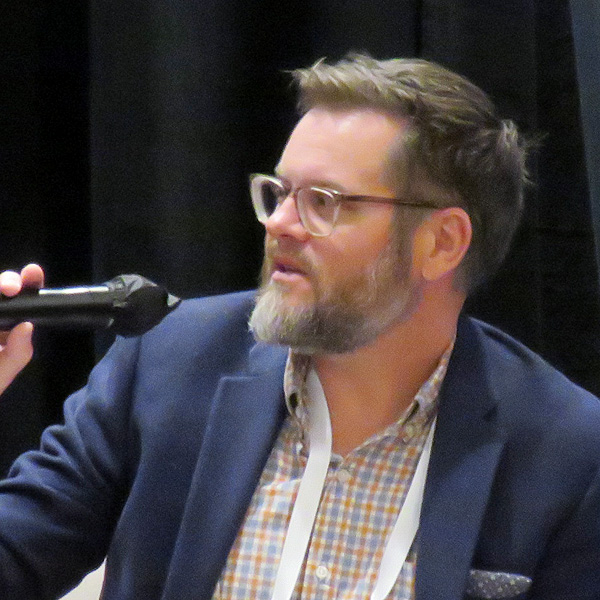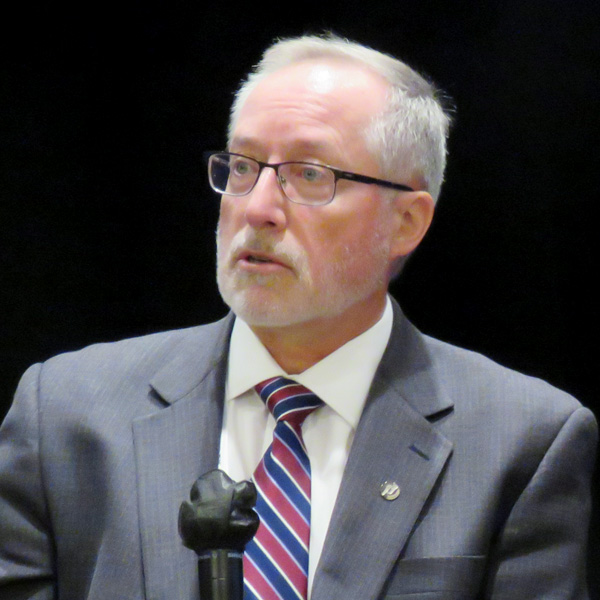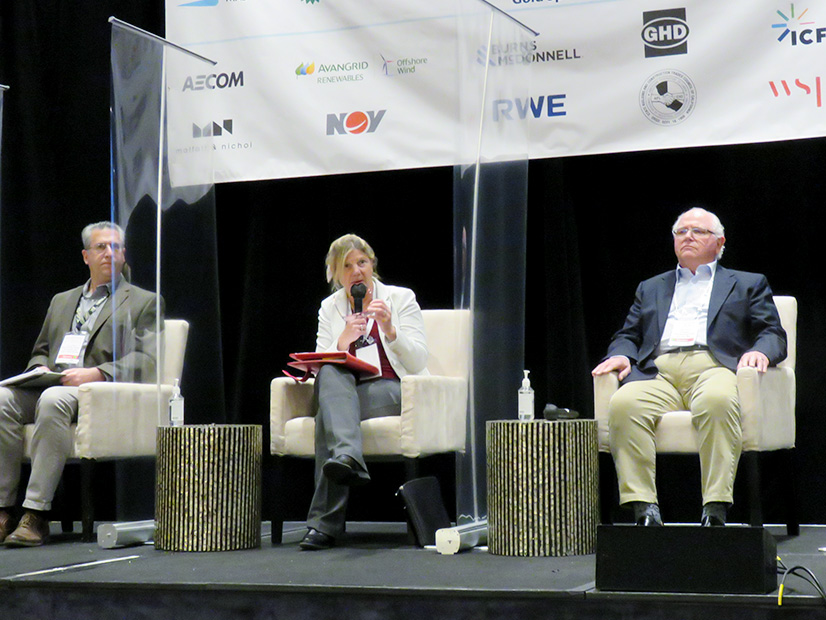
SAN FRANCISCO — Offshore wind is expected to progress steadily in California over the next decade, but panelists at last week’s Pacific Offshore Wind Summit in San Francisco expressed concern that the infrastructure needed to support floating wind farms could lag development plans.
New to offshore wind, the West Coast will need to build high-voltage transmission lines, port facilities and assembly areas for massive wind turbines. The region lacks a trained workforce for offshore wind and a dedicated, on-time supply chain. And it still must develop a strategic plan, as required by last year’s California Assembly Bill 525, to make offshore wind part of its 100% clean energy initiative.
 Eli Harland, California Energy Commission | © RTO Insider LLC
Eli Harland, California Energy Commission | © RTO Insider LLC“We’re going to develop a strategic plan under AB 525, but it will only mean anything to the industry and to the climate if there’s a way to implement that strategic plan,” Eli Harland, adviser to California Energy Commission member Kourtney Vaccaro, said in a panel on regional cooperation.
“That’s not going to get done with a couple of people in the Energy Commission pushing it forward,” Harland said. “That’s going to take a resource commitment that, if we don’t make it, we’re going to find ourselves really behind when the industry takes off, and we’re not going to be ready for construction and operation.”
Stakeholders at the conference said a best-case scenario would be for the infrastructure work to happen in the years between a pending lease auction and the start of construction.
The West Coast’s first offshore lease auction will be held later this year for two areas off Northern and Central California, Amanda Lefton, director of the Bureau of Ocean Energy Management (BOEM) told the audience, prompting spontaneous applause.
“Let me be clear,” Lefton said. “We are going to hold a statewide offshore wind energy lease sale in California this year. The sale will offer up wind energy areas in the northern and central coasts, and these areas will enable the buildout of significant new domestic clean energy over the next decade or more. This will also help California reach its carbon-free energy goal by 2045.”
The California auction is part of the Biden administration’s goal to develop 30 GW of offshore wind by 2030, Lefton said.
“We plan to release a proposed sale notice later this spring,” she said. “This notice gives you all the first look at the [proposed] terms and will ask for feedback on important initiatives for … labor agreements, credits for domestic supply chain investments, engagement with tribal nations and ocean users, and working with the commercial fishing industry.”
Panelists at the conference, hosted by trade group Offshore Wind California and organizer Infocast, addressed challenges including port construction, transmission coordination and supply chain issues.
Transmission
The two wind energy areas that BOEM plans to auction this year have distinct transmission states.
 Neil Millar, CAISO | © RTO Insider LLC
Neil Millar, CAISO | © RTO Insider LLCThe Morro Bay Wind Energy Area in Central California is “well-positioned” because it’s already served by transmission lines to the defunct Morro Bay Power Plant and the soon-to-be retired Diablo Canyon Power Plant, the state’s last nuclear generator, Neil Millar, CAISO vice president of infrastructure and operations planning, said in a panel on transmission and interconnections.
There already is ample transmission capacity for the 3 GW that Morro Bay wind is expected to generate and more when Diablo Canyon closes, Millar said.
A growing movement of scientists and elected officials has argued for keeping the 2,256-MW Diablo Canyon plant open for reliability’s sake during California’s clean energy transition. If that happens, it will significantly limit available transmission capacity.
The Humboldt Bay Wind Energy Area, in contrast, requires “starting from scratch” to carry the 1.6 GW it is anticipated to generate, Millar said.
“It’s all about Humboldt,” he said.
Unserved by major transmission lines, the Humboldt area on California’s sparsely populated North Coast would require a new line that crosses rugged mountains to connect to the Pacific AC Intertie, one of the state’s major north-south transmission corridors, or an undersea cable that surfaces near San Francisco, he said.
The Humboldt area is being examined as part of CAISO’s new 20-year transmission outlook and in collaboration with the California Public Utilities Commission and the Energy Commission, Millar said.
Coordinated transmission, instead of the serial connections that became a problem for East Coast wind, is a priority on the West Coast, panelists said.
Since late February, when BOEM announced three new wind energy call areas in southern Oregon, there has been talk of coordinating transmission links between the two states. (See Energy Bar Weighs OSW in Oregon, California.)
“The growing Pacific Coast scale of this, which has just been expanded [with BOEM’s Feb. 24 announcement] … sets in motion a whole set of speculation about coordination across the region,” Adam Stern, executive director of Offshore Wind California, said at the time.
In far northern California, there are potential wind-farm areas off the coast near Crescent City, Arne Jacobson, director of the Schatz Energy Research Center at Cal Poly Humboldt, said. If those areas are eventually slated for wind development, transmission coordination with the southern Oregon areas might be an efficient solution, he said.
The Port of Coos Bay in southwest Oregon is also hoping to play a role in offshore wind, port CEO John Burns said in a panel on seaport facilities and staging areas. Once a major timber port, it still owns 1,000 acres that could be used to support offshore wind.
Ports
In the seaport session, panelists said that while Humboldt lacks transmission, it has what wind developers consider a nearly ideal bay and spacious quayside to assemble turbines and transport them to sea.
The Port of Humboldt Bay recently received a $10.5 million grant from the Energy Commission to begin upgrading its facilities for wind development.
The funds will help the Humboldt Bay Harbor, Recreation and Conservation District revitalize the historic timber port on the state’s Redwood Coast, beginning with preliminary engineering and design work. The money will also be used to attract matching grants from the federal government.
A new marine terminal is being planned to handle heavy cargo vessels and floating platforms. Humboldt Bay lacks the bridges and other impediments to developing wind ports in larger deep-water harbors, such as San Francisco and San Diego bays.
In Humboldt, the port is “foundational infrastructure” that might be ready for wind deployment in five to six years, about the same timeframe as the permitting process for sites in the Humboldt Bay Wind Energy Area, Jacobson said.
New transmission to Humboldt is likely to take longer, he said.
Larry Oetker, executive director of the Humboldt Bay harbor district, offered a similar assessment.

“Our goal is to have all the permits and to be ready to go within the next few years,” Oetker said. “We want the work to be ready when the offshore wind industry is ready, and we don’t want the port to be an obstacle. And so simultaneously [with technical studies] we’re working on workforce development and transmission upgrades. Because in the end, the transmission upgrades and the offshore wind leases and future offshore wind leases are going to dictate the amount of port investment that’s going to be needed.”
In Central and Southern California, it is less clear which ports will be primary staging areas for the Morro Bay wind fleet.
The Port of Long Beach in Los Angeles County, one of the world’s busiest container ports, is interested in playing some part, possibly in conjunction with other ports that have different strengths, Matt Arms, the port’s director of environmental planning, said.
Kristin Decas, CEO of the Port of Hueneme in Ventura County, made a pitch for its potential to be the best staging area for Morro Bay. The deep-water harbor is home to Naval Base Ventura County and is a major entry port for cargo ships carrying cars and bananas.
“Right now, we sit as the sixth leading port on the West Coast for commercial cargo,” Decas said. “We are actually moving more cargo than Portland and Boston right now. We’re the fourth largest container port in the state of California.”
When panelists were asked if building a new port made sense, Decas said building a new port is a “heavier lift” than building a wind farm.
“I don’t think that’s going to be your answer,” she said.
Supply Chain, Floating Turbines
Several panels addressed supply chain issues, including a session on cabling and mooring. Whether the supply chain can provide “just in time” delivery for West Coast wind development remains doubtful, panelists said.
Bill Wall, project director at LS Cable Systems America, which made undersea cable for the first U.S. wind farm, Block Island, and subsequent projects, said his company has a two-to-three-year backlog in its factories, making delivery times uncertain.
Tom Fulton, head of renewables and mooring development at marine energy and infrastructure firm Acteon, asked audience members to imagine how much room it would take to store equipment for even a 1-GW wind farm if the equipment could not be installed promptly.
Developers are expecting to install enormous 15-MW floating turbines off the West Coast, each more than 900 feet tall with blades longer than a football field. A 1-GW wind farm will require 67 towers along with miles of anchoring and mooring gear. The links in an anchor chain weigh half a ton; polyester cable used instead of chain is a foot thick, Fulton said.
The floating platforms will be in water 2,000 to 4,000 feet deep, but that should not be a problem, panelists said.
Oil platforms have operated at such depths for years, Fulton said.
Henrik Stiesdal, CEO of offshore wind developer Stiesdal A/S, acknowledged floating wind is still in its infancy as an industry but said the technology has been proven since 2009. The West Coast won’t require entirely new designs, he said as part of a panel on floating turbines.
Asked for final thoughts on floating offshore wind, Stiesdal said, “It’s the future,” while other panelists commented that it is a way to harness large amounts of wind energy and to use its scale as a means of producing clean power.
California hopes to eventually have 10 GW or more of offshore wind.
Aaron Smith, chief commercial officer of wind developer Principle Power, said: “I agree with you guys, but it’s also going to take a lot of coordinated effort to build the capabilities to make this happen, so we really need to focus and get started now.”
